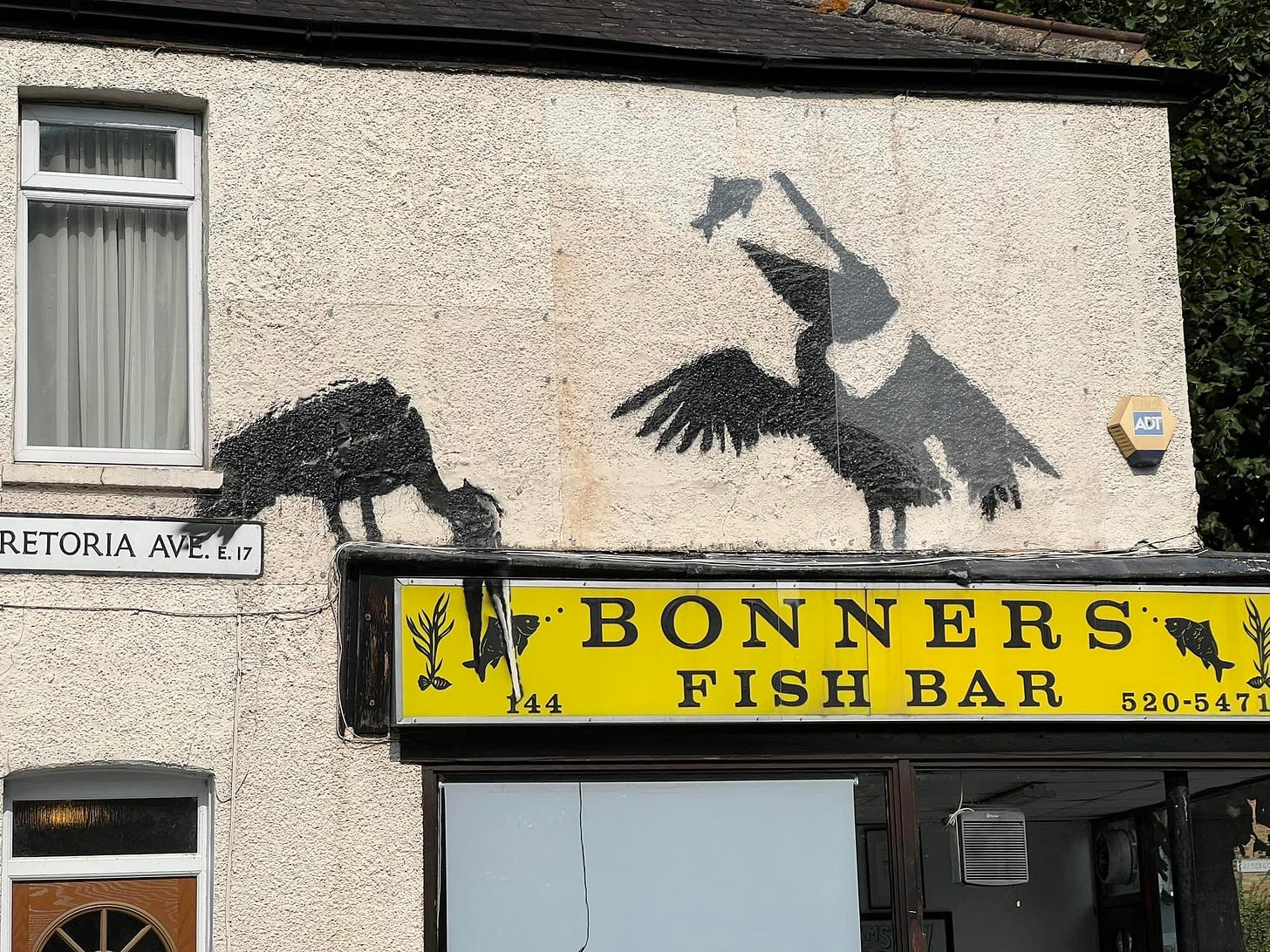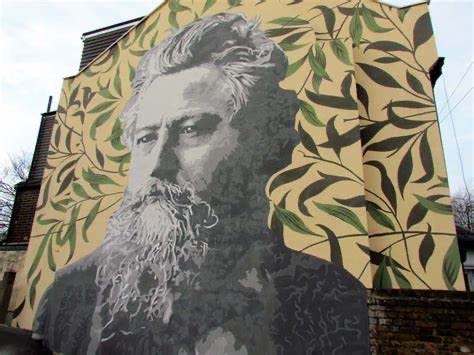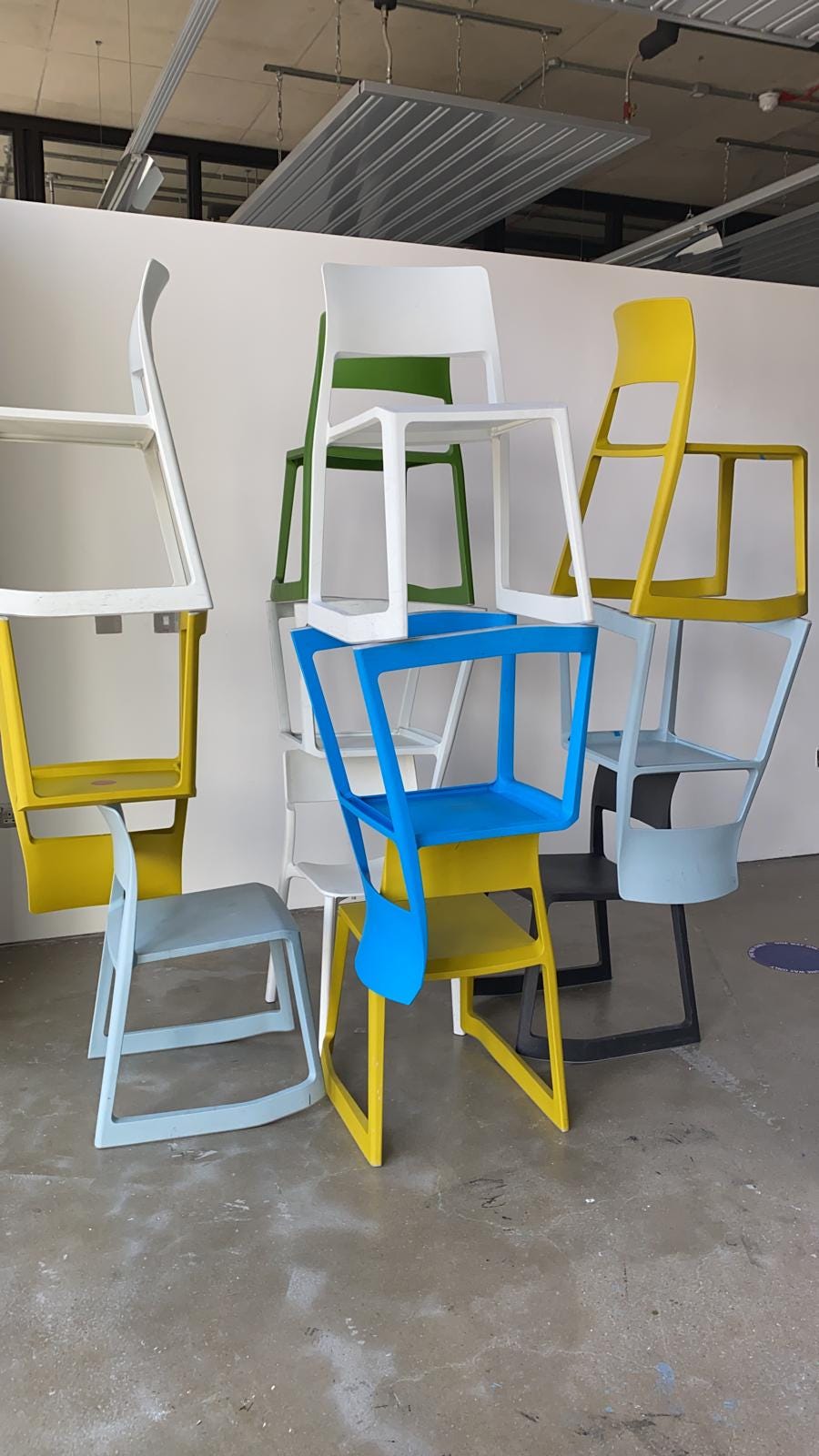A few weeks ago in early August, the street artist/political activist Banksy went on a late night graffiti spree, stenciling a series of black animal silhouettes in public spaces across London. Walthamstow got a pair of Banksy pelicans, joyfully tossing and eating the fish off the sign on a local chip shop, Bonners Fish Bar.
Some people are sniffy about Banksy, reckoning him a fraud for his anonymity and a con-man for the eye-watering sums his works sell for at auction. But the people of E17 had a different reaction (which was Very Walthamstow), typical of how folk in this community respond to creativity, whether it is on walls or allotments.
The Banksy Shot
Bonners is something of an E17 institution. There’s no apostrophe. The fish and chips are reliably great. The family who run it take a traditional long holiday break every summer, so they weren’t in the ‘Stow to see the Banksy happen. They saw all the action unfold on their own social media accounts as more and more people shared photos of the pelicans.
In their absence, the local E17 community rallied around to make sure that the artwork wasn’t defaced or stolen. Neighbours sat out on the street in deck chairs, on improvised Banksy Watch. Our MP Stella Creasy worked with Waltham Forest council to set up a security patrol, and a studio collective of local street artists who had the proper kit to do the job professionally, Wood Street Walls , protected the work by covering it in clear perspex panels (which you can just about see in the photo above).
Several weeks later, the family are now back from their holiday and Bonners has reopened for business. An appreciative queue of customers admire the Banksy as they wait for their orders. The mural has become a local talking point, ‘‘Is it ‘art’?’’ banter bubbling over hot vinegary chips wrapped open in paper and eaten on the street. Everyone seems genuinely delighted that Banksy chose Walthamstow for one of his works.
Plot work in progress
Back on the allotment, it is very firmly autumn now.
Every session on the plot starts with picking up windfall apples from our four trees (two Lord Lambournes, a Worcester and a Discovery) to avoid much skating and slipping on the grass paths. When we were new to the plot and still having to strim down the grass paths to maintain some sense of order, this time of year always led to being slapped in the face by squished apples thrown up by the strimmer. Over the years I’ve learned to collect the windfalls more carefully as a result. Rotting apple pulp does *not* work as a skin serum, friends.
We keep the best windfalls for cooking and distributing to neighbours via a cardboard box outside our front door, but we chuck the very bruised or obviously worm-ridden ones into a bucket of water to drown any inhabitants and stop them re-infecting the trees next year.
We’ve also got birds eating more of our apples this year than I’ve ever noticed before. The most irritating are the green ring-necked parakeets, who ruin an apple with a few pecks here and there, then move on to the next one. I don’t mind sacrificing a few fruit to the birds, but multiple apples each ruined by one or two pecks has been frustrating. But if I thought that was bad this is apparently what hungry magpies do to ripe apples.
At this rate, I might as well toss a few apples up to Banksy’s pelicans and see what they can do with them. Of course, my plot neighbours said the answer is to put *all* of the apples as they grow into organza bags, as the bags will hide the crop from birds. We are going to need *even more* organza bags next year!
Harvesting now
This week our family pear tree, which is a small tree with three varieties of pear grafted onto a single trunk and rootstock, gave up its first two ripe fruit. These are our first full-grown ‘Williams’, and they are truly Fruit of Joy1.
In the case of the pears, I *did* use organza bags to protect the entire crop of twelve fruit on the tiny tree. Luckily, both Williams dropped in the week, and the bags held them, still tied to the branch, until I got to the plot on Sunday. The ‘Comice’ and ‘Conference’ are still ripening inside their bags. It’s fascinating that the fruit on each graft ripen in seasonal order, exactly as they would on separate full-sized trees.
The tomato harvest is winding down now. The larger beefsteaks are all harvested and eaten, but we are picking off the piccolo baby plum ‘Datterini’ as they ripen. (Or perhaps they’re ‘Muscato’? - I seem to have mixed up the seed packets and the labels. Oops.) These are our go-to breakfast tomato, perfect lightly fried in olive oil with a dash of rose harissa. We haven’t bought supermarket tomatoes for weeks now, and they have added to the produce tally.2
The ‘Shimmer’ tomatoes are my favourite variety this year.3 They’ve not been as prolific as the baby plums so far but they are taking longer to ripen on the vines. Maybe something to do with the darker greenish-bronze striped skins?
Also harvested this week, a few hot Turkish-style peppers4. Really hot, really great charred on a barbeque. We chopped a couple on a pepperoni and n’duja supermarket pizza for extra zing.
Making and eating
Given the continuing tsunami of apples we made more jam, this time an apple and blackberry jam with a generous slosh of Navy-strength gin5 in the preserving pan.
This is the jam haul from this 2024 summer season so far. There are a couple of jars of apricot and kernel jam just out of shot to the left, some greengage and pecan and then various beautiful purple combinations of apple, blackberries and damsons. I definitely need to start the plot produce tally at the start of the season next year.6
Can you tell that things have got *slightly* out of hand in the home preserving department? Can you also tell just how much I love a label maker?
Local Heroes
Given all the hoo-ha about the Banksy pelicans mural, it has been good to see that street art studio collective Wood Street Walls are adding more art to our local walls. I can see three new murals taking shape on the seven minute walk from my house to the nearest tube station. I can’t wait to show them to you all here over the next weeks.
What’s great about Wood Street Walls is that they pay their artists a set fee for the work, regardless of how well known they are, and they’re involved in community projects all over Waltham Forest. They’ll support small businesses to get public engagement with their brand using art, create a memorial for a good local cause or help smarten up a shopfront. Mainly they’re all about raising awareness of the need to pay artists for their professional work (‘exposure’ doesn’t pay the bills, folks) and that artists need affordable studio spaces to develop their creative practice.
Thanks to Wood Street Walls, murals are A Thing in Walthamstow, and various houses, shops and pubs have been painted by different members of the collective. There are a couple of maps on their website showing who the artists are for each mural.
Perhaps the most well-known in our part of Walthamstow is the mural of William Morris in the car park on Bedford Road, next to the William Morris Gallery. This is by the street artist Matt Dufour, tagged as ATMA.
I’m sure Mr. Morris will feature in future episodes here, as he pops up all over Walthamstow. I need to go and take another photo of his mural.
Community of Practice
I re-titled this section of my post from previous episodes as I realised that I’d been so excited about sharing photos of our allotment produce on Substack each week that I’d lost sight of the thing that spurred me to start this Substack six weeks ago - namely wanting to reflect on allotments at their best being true communities of practice. Luckily, the good people at Wood Street Walls reminded me with their new murals.
Creative practice is something I’ve had the privilege to be immersed in, having spent the last six years of my career in art and design higher education in the UK. I’ve worked in two of the UK’s finest art schools, Central Saint Martins and the Royal College of Art, and the development of creative practice is vital to students and to practitioner faculty in both institutions. Both have an emphasis on learning through doing and making, of developing design thinking through physical activity practiced in shared studio spaces.
I’ve learnt a lot from art schools and a lot from allotments, in similar ways.
I have learnt from the small group of plot neighbours I am most friendly with on the site. We all grow different things, in our different ways and we all have successes and failures in each growing season. The main thing is that we all learn by our individual and collective ‘doing’ - our sowing, planting, digging, pruning and growing. We share our successes and our failures as much as our fruit and veg produce, and we work out how to make our growing better the following year.
I’m aiming to capture some idea of the learning here each week. Some stuff will work, some won’t. Most things will need more practice.
Two ripe ‘Williams’ pears, cost £1.75.
Piccolo ‘Datterini’ baby plum tomatoes, equivalent to six 360g portions, cost £3.90 each, total £23.40.
‘Shimmer’ tomatoes, two 180g portions, cost £3 each, total £6.
Turkish peppers are currently £1.95 for a bag of six in our local Turkish-run shop, so I’ve allowed £1 for these in this week’s tally.
Four 190g jars of hand-made organic apple and blackberry jam, £5 each, total £20.
Total for this week £52.15, total to date £70.15. Not bad for two weeks’ produce, based on comparison with current supermarket prices.
















Loved this! I live over on the other side of London and I don’t know Walthamstow at all but have been contemplating making the journey to the William Morris Gallery. I really enjoyed this slice of life and the way the community comes together. Plus, your allotment sounds phenomenal!